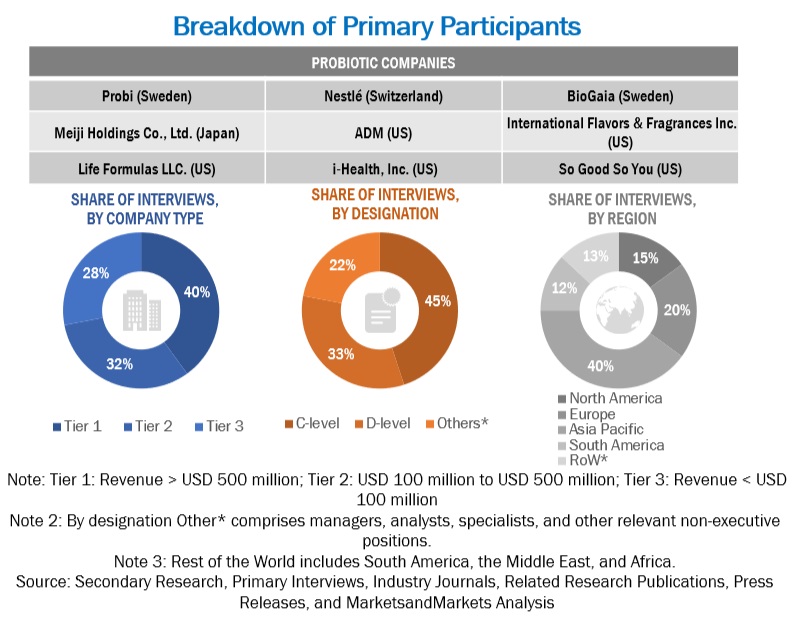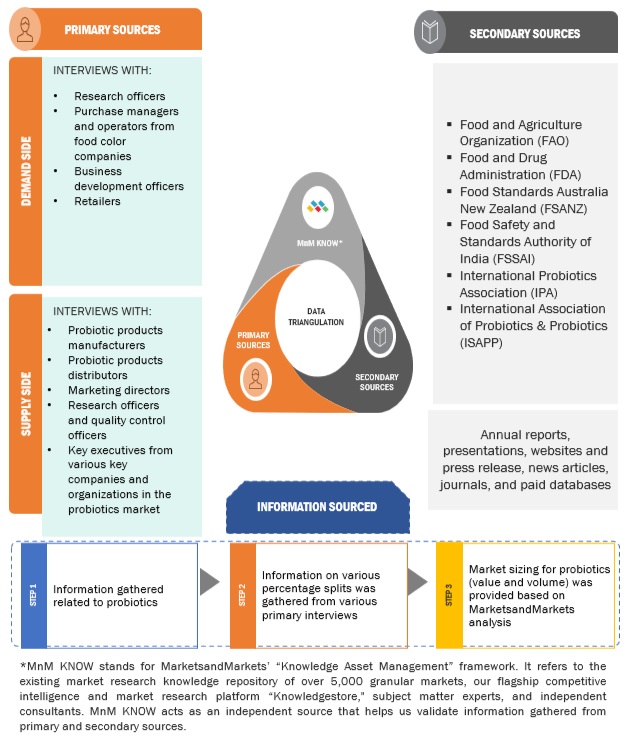This research involves the extensive use of secondary sources; directories; and databases (Bloomberg and Factiva) to identify and collect information useful for a technical, market-oriented, and commercial study of the Probiotics market. In-depth interviews were conducted with various primary respondents, such as key industry participants, Subject Matter Experts (SMEs), C-level executives of key market players, and industry consultants, to obtain and verify critical qualitative and quantitative information and to assess prospects.
Secondary Research
In the secondary research process, various sources, such as the Food and Agricultural Organization (FAO), United States Department of Agriculture (USDA), U.S. Food and Drug Administration (FDA) U.S. Food and Drug Administration (FDA), European Food Safety Authority (EFSA), World Health Organization (WHO), Consumer Healthcare Products Association (CHPA), European Federation of Associations of Health Product Manufacturers (EHPM), Canadian Health Food Association (CHFA), and Health Food Manufacturers' Association (HFMA), associations were referred to identify and collect information for this study. The secondary sources also include journals, press releases, investor presentations of companies, whitepapers, certified publications, articles by recognized authors and regulatory bodies, trade directories, and paid databases.
Primary Research
The Probiotics market encompasses various stakeholders involved in the supply chain, raw material manufacturers, raw material suppliers, regulatory organizations, and research institutions. To gather comprehensive information, primary sources from both the supply and demand sides were engaged. Primary interviewees from the supply side consisted of manufacturers, distributors, importers, and technology providers involved in the production and distribution of Probiotics. On the demand side, key opinion leaders, executives, and CEOs of companies in the Probiotics industry were approached through questionnaires, emails, and telephonic interviews. This approach ensured a comprehensive and well-rounded understanding of the Probiotics market from various perspectives.

To know about the assumptions considered for the study, download the pdf brochure
Market Size Estimation
The top-down and bottom-up approaches were used to estimate and validate the market’s and various dependent submarkets’ size. The research methodology used to estimate the market size includes extensive secondary research of key players, reports, reviews, and newsletters of top market players, along with extensive interviews from leaders, such as CEOs, directors, and marketing executives.
Global Probiotics Market Size: Top-Down Approach


To know about the assumptions considered for the study, Request for Free Sample Report
Global Probiotics Market: Data Triangluation
After arriving at the overall size from the market size estimation process explained above, the total market was split into several segments and subsegments. The data triangulation and market breakdown procedures explained below were implemented, wherever applicable, to complete the overall market engineering process and arrive at the exact statistics for various market segments and subsegments. The data was triangulated by studying various factors and trends from the demand and supply sides. Along with this, the market size was validated using both the top-down and bottom-up approaches.

Market Definition
The joint Food and Agriculture Organization (FAO)/World Health Organization (WHO) working group defines probiotics as “live micro-organisms, which when administered in adequate amounts confer a health benefit on the host” (FAO/ WHO, 2001).
Probiotics are living microorganisms that have been shown to provide specific health benefits to consumers. They are known to support gut health and help in running the digestive system smoothly. Yogurt is one of the prime natural sources of probiotics.
According to the National Center for Complementary and Integrative Health, “Probiotics are live microorganisms that are intended to have health benefits when consumed or applied to the body.” The major function of probiotics is to maintain a healthy balance in the body. Several types of microorganisms are present in probiotics, and they may have different effects on the body. The most common bacteria belong to the group called Lactobacillus and Bifidobacterium.
Key Stakeholders
-
Manufacturers, Importers and Exporters, Traders, Distributors, and Suppliers of Probiotics
-
Nutraceutical Manufacturers
-
Food Processors and Manufacturers
-
Government and Research Organizations
-
Trade Associations and Industry Bodies
-
Regulatory bodies and associations are as follows:
-
Food Agriculture Organization (FAO)
-
World Health Organization (WHO)
-
International Dairy Federation (IDF)
-
European Food & Feed Cultures Association (EFFCA)
-
National Yogurt Association (NYA)
-
International Scientific Association for Probiotics and Prebiotics (ISAPP)
-
International Probiotics Association (IPA)
-
Council for Responsible Nutrition (CRN)
-
National Yogurt Association (NYA)
-
International Frozen Yogurt Association (IFYA)
-
American Nutrition Association (ANA)
Report Objectives
-
To define, segment, and project the global market for Probiotics on the basis of product type, ingredient, distribution channel, end user, and region
-
To provide detailed information regarding the key factors influencing the growth of the market (drivers, restraints, opportunities, and industry-specific challenges)
-
To strategically analyze the micro markets with respect to individual growth trends, future prospects, and their contribution to the total market
-
To analyze the opportunities in the market for stakeholders and provide a competitive landscape of the market leaders
-
To project the size of the market and its submarkets, in terms of value with respect to the regions (along with the key countries)
-
To strategically profile the key players and comprehensively analyze their market position and core competencies
-
To analyze competitive developments in the Probiotics market, including joint ventures, mergers & acquisitions, new product developments, and research & development activities
Available Customizations:
With the given market data, MarketsandMarkets offers customizations according to company-specific scientific needs.
The following customization options are available for the report:
Product Analysis
-
Product Matrix, which gives a detailed comparison of the product portfolio of each company
Geographic Analysis
With the given market data, MarketsandMarkets offers customizations according to company-specific scientific needs.
-
Further breakdown of the Rest of the European Probiotics market, by key country
-
Further breakdown of the Rest of the Asia Pacific Probiotics market, by key country
-
Further breakdown of the Rest of South America Probiotics market, by key country
Company Information
-
Detailed analyses and profiling of additional market players



Growth opportunities and latent adjacency in Probiotics Market